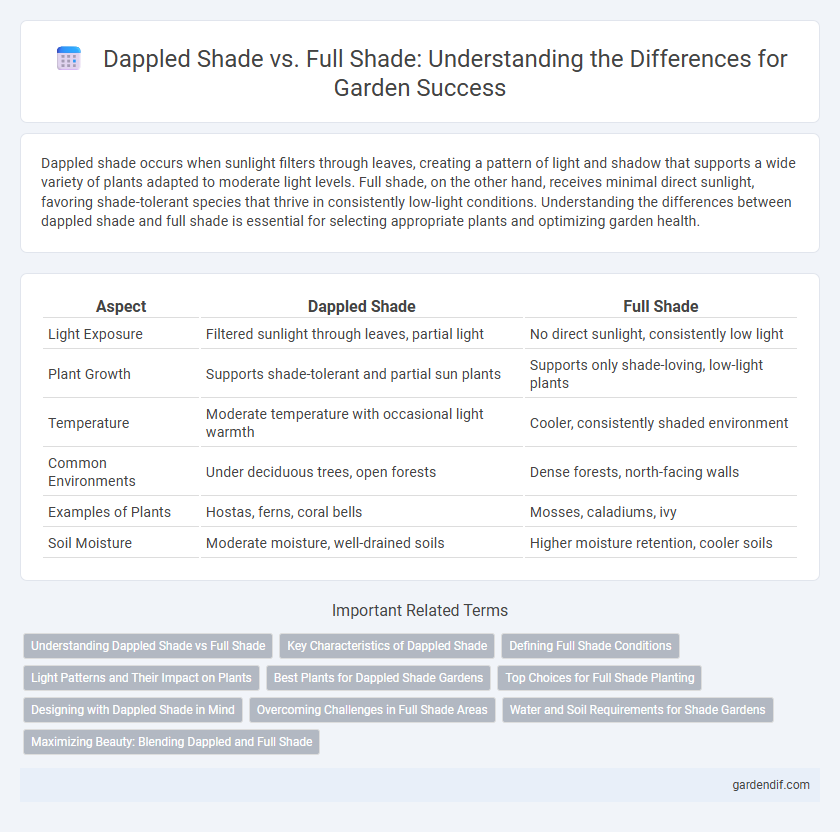
dappled shade vs full shade Illustration
Dappled shade occurs when sunlight filters through leaves, creating a pattern of light and shadow that supports a wide variety of plants adapted to moderate light levels. Full shade, on the other hand, receives minimal direct sunlight, favoring shade-tolerant species that thrive in consistently low-light conditions. Understanding the differences between dappled shade and full shade is essential for selecting appropriate plants and optimizing garden health.
Table of Comparison
| Aspect | Dappled Shade | Full Shade |
|---|---|---|
| Light Exposure | Filtered sunlight through leaves, partial light | No direct sunlight, consistently low light |
| Plant Growth | Supports shade-tolerant and partial sun plants | Supports only shade-loving, low-light plants |
| Temperature | Moderate temperature with occasional light warmth | Cooler, consistently shaded environment |
| Common Environments | Under deciduous trees, open forests | Dense forests, north-facing walls |
| Examples of Plants | Hostas, ferns, coral bells | Mosses, caladiums, ivy |
| Soil Moisture | Moderate moisture, well-drained soils | Higher moisture retention, cooler soils |
Understanding Dappled Shade vs Full Shade
Dappled shade occurs when sunlight filters through leaves, creating a pattern of light and shadow ideal for shade-tolerant plants like ferns and hostas. Full shade refers to areas receiving less than two hours of direct sunlight daily, supporting plants that thrive in low-light environments such as ivy and moss. Understanding the differences between dappled shade and full shade is crucial for selecting appropriate plant species and ensuring optimal growth conditions.
Key Characteristics of Dappled Shade
Dappled shade is characterized by intermittent sunlight filtered through the gaps of tree leaves, creating patterns of light and shadow on the ground. This type of shade provides moderate light levels, supporting the growth of shade-tolerant plants like ferns, hostas, and astilbes that require partial sunlight for photosynthesis. Unlike full shade, dappled shade offers a balance of sun exposure and protection from intense heat, making it ideal for diverse garden ecosystems.
Defining Full Shade Conditions
Full shade conditions are characterized by less than two hours of direct sunlight per day, typically found under dense tree canopies or the north side of buildings. Unlike dappled shade, which allows intermittent sunlight through filtered leaves, full shade offers consistent low-light levels ideal for shade-loving plants such as ferns, hostas, and astilbes. Understanding these conditions helps gardeners choose appropriate plant species that thrive with minimal sunlight exposure.
Light Patterns and Their Impact on Plants
Dappled shade provides intermittent sunlight filtered through tree leaves, creating a dynamic light pattern that promotes healthy photosynthesis in shade-tolerant plants by mimicking natural forest understories. Full shade offers consistently low light conditions, which can limit photosynthetic activity and slow plant growth but benefits species adapted to minimal light exposure. Understanding these light patterns helps gardeners select suitable plants, optimizing growth by matching species to their ideal light environment.
Best Plants for Dappled Shade Gardens
Dappled shade gardens thrive with plants like hostas, ferns, and astilbes, which adapt well to the filtered sunlight beneath trees. These plants efficiently balance light and moisture needs, preventing the leggy growth common in full shade conditions. Incorporating native species such as columbines and bleeding hearts enhances biodiversity while ensuring resilience in dappled shade environments.
Top Choices for Full Shade Planting
Top choices for full shade planting include hostas, ferns, and astilbes, known for thriving with minimal sunlight. Unlike dappled shade that allows intermittent light, full shade plants require consistently low light levels to flourish. Selecting species adapted to full shade conditions ensures healthy growth and vibrant foliage in shaded garden areas.
Designing with Dappled Shade in Mind
Designing with dappled shade in mind enhances garden aesthetics by leveraging partial sunlight filtered through tree canopies, ideal for shade-tolerant plants like ferns, hostas, and astilbes. Unlike full shade, which restricts plant diversity due to minimal light, dappled shade provides intermittent sunlight, promoting lush growth and vibrant foliage. Incorporating layered planting techniques and selecting species adapted to variable light conditions optimize the use of dappled shade in landscape design.
Overcoming Challenges in Full Shade Areas
Dappled shade provides intermittent sunlight filtered through tree leaves, supporting a wider variety of plants compared to full shade, which receives minimal direct light. Overcoming challenges in full shade areas involves selecting shade-tolerant plants like ferns, hostas, and astilbes that thrive with low light and maintaining soil fertility to enhance plant health. Incorporating reflective surfaces or light-colored mulches can also improve light availability, promoting growth and resilience in dense shade conditions.
Water and Soil Requirements for Shade Gardens
Dappled shade gardens typically require well-drained, consistently moist soil to support plants that tolerate intermittent sunlight, ensuring optimal water retention without saturation. Full shade gardens demand soil with high organic matter content and moisture-holding capacity to compensate for lower evapotranspiration rates, reducing the frequency of irrigation. Proper water management in both shade conditions prevents root rot and nutrient leaching, promoting healthy plant growth.
Maximizing Beauty: Blending Dappled and Full Shade
Maximizing garden beauty involves skillfully blending dappled shade and full shade to create dynamic plant palettes. Dappled shade, characterized by filtered sunlight through tree canopies, supports vibrant understorey growth and diverse flowering species, while full shade areas favor shade-tolerant ferns, hostas, and ivy. Combining these shade conditions enhances texture variety, color contrasts, and seasonal interest, resulting in a visually rich and sustainable landscape design.
dappled shade vs full shade Infographic

 gardendif.com
gardendif.com